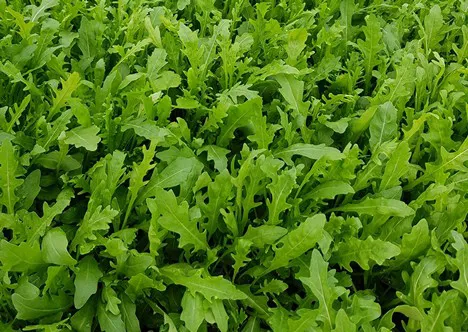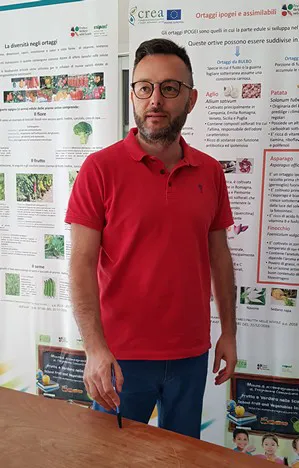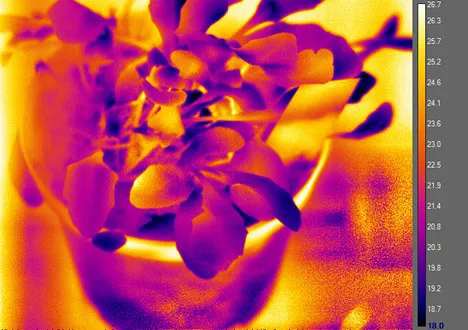"The purpose of research is to innovate production systems with the help of digital technologies so as to contribute to the realization of important objectives for future agriculture, such as: producing more while eliminating waste, optimizing the use of inputs, and minimizing the negative impacts on the environment with an approach that is as sustainable as possible.
"Our research activity stems from the need to acquire information and knowledge to create new sensors capable of helping producers monitor the health of plants and be supported when it comes to management. Specifically, we are developing digital imaging systems - i.e., non-destructive quick analyses that can be applied on a large scale - to monitor the evolution of the diseases caused by soil-borne pathogens on wild arugula baby leaves," reports Catello Pane, a researcher at CREA-Centro di Ricerca Orticoltura e Florovivaismo di Pontecagnano Faiano (Salerno) and scientific manager of the action titled "Diagnosi precoce di stress fitopatologici soil borne in rucola mediante IR imaging" (Early diagnosis of soil-borne phytopathologic stresses on arugula via IR imaging).

This activity is developed as part of the PN R&I 2014-2020 project called: "Conservabilità, qualità e sicurezza dei prodotti ortofrutticoli ad alto contenuto di servizio - POFACS" (Shelf-life, quality and safety of produce with a high service content) financed by the Ministry for Education, University and Research coordinated by Teodoro Cardi. Studies have been conducted by Catello Pane with the support of CNR-ISASI in Pozzuoli.
 "The research activity focused on wild arugula (Diplotaxis tenuifolia), as this crop plays an important role when it comes to fresh-cut production. To increase the sustainability of fresh-cut ready-to-eat chains, in order to improve crop defense while at the same time obtaining the reduction or absence of residues in the product, management can be integrated with digital systems that enable the reduction of plant protection products, focusing interventions only on the plants actually affected by the infection thus blocking the spreading of the disease and saving up treatments for the next phases," reports Catello Pane (in the photo).
"The research activity focused on wild arugula (Diplotaxis tenuifolia), as this crop plays an important role when it comes to fresh-cut production. To increase the sustainability of fresh-cut ready-to-eat chains, in order to improve crop defense while at the same time obtaining the reduction or absence of residues in the product, management can be integrated with digital systems that enable the reduction of plant protection products, focusing interventions only on the plants actually affected by the infection thus blocking the spreading of the disease and saving up treatments for the next phases," reports Catello Pane (in the photo).
"Specifically, IR Imaging is used for this research activity. We took advantage of the capability of some optoelectronic sensors known as thermographic to acquire the emission spectrum of the plant's thermal energy, whose intensity is directly attributable to its physiological state and health. By employing this principle, it is possible to develop systems that can identify healthy and sick plants. This occurs because when a plant is attacked by a pathogen, it initiates a series of defense responses during the first phases of the infection that alter its capability of cooling. Therefore plants affected by the attack will have a higher temperature than healthy plants."
 Thermography of an arugula plant
Thermography of an arugula plant
"Diagnosing a disease already during the first phases of plant-pathogen interaction compared to naked-eye monitoring poses the following advantages: it enables to take action promptly against the propagation of the infection; it enables to carry out specific treatments and, in the long term, it reduces the treatments needed in subsequent phases, thus making crops increasingly sustainable form an economic and environmental point of view. By isolating hotbeds as soon as possible, the risk of the infection propagating is reduced, but the benefit also concerns future crops, as these systems also reduce spreading to later crops, increasing the effectiveness of organic productions."
"Together with Massimo Rippa (CNR-ISASI), who supports our research activities, we have understood that, in order to be able to read a significant response from plants, we need to use active thermography, i.e., plants must be stimulated with an external light source before we acquire its energy emission."
"This innovation is already in use by various digital supports. What is important is to test plant-pathogen interaction to assess the progression and responses and implement its use in other systems. Our aim is to acquire information and new knowledge and make them available to the companies that manufacture digital supports. Said systems enhance sensing capability and do not replace operators who, after acquiring imaging information, will have additional elements on which to base their decisions."
For further information:
catello.pane@crea.gov.it
